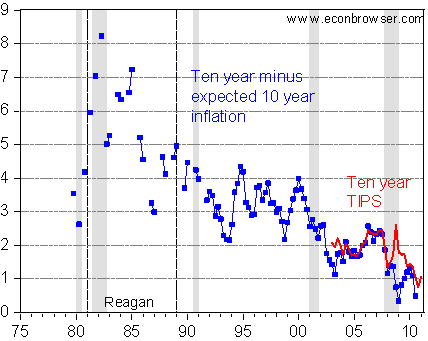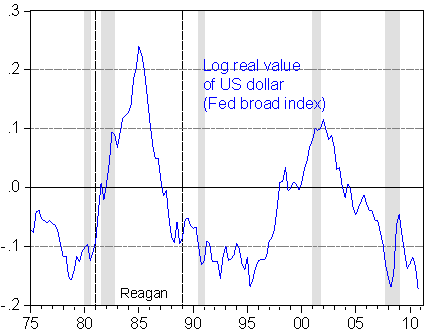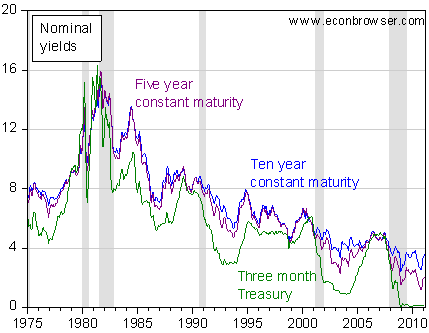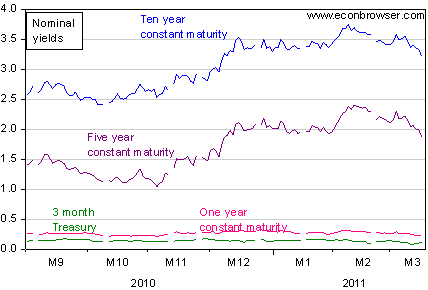Recent commentary on whether real interest rates rose during the Reagan era tax cuts — Kling responding to Krugman — impelled me to look at the data…

Figure 1: Ten year constant maturity Treasurys minus ten year expected inflation (Blue Chip; Philadelphia Fed Survey of Professional Forecasters) (blue line), and Ten year constant maturity TIPS (red line), 1975-2010. Nominal yields are average of three months in quarter; expected inflation generally pertains to mid-quarter month. NBER defined recession dates shaded gray. Source: St. Louis Fed FREDII, Philadelphia Fed, NBER and author’s calculations.
It appears to me that real interest rates were undeniably higher during the Reagan administration than during, say, the past four quarters of the Obama administration. The difference is 4.56 percentage points, and is statistically significant with p-value of 0.000, using Newey-West standard errors. (I know some people have argued that we should take into account Fed measures; I agree. But those only account for a relatively small proportion of interest rate levels [0].)
Nostalgia time: I remember taking an intermediate macro course at the time of Reagan’s election; the professor (James Duesenberry) predicted crowding out, particularly in business fixed investment (as I recall — my memory of this might be faulty after 30 years). As it turned out, crowding out occurred much more profoundly via net exports, as the dollar surged. When one looks at this alternative mode of “crowding out”, the crowding out argument looks even more, well, lacking of data-based evidence.

Figure 2: Log real value of US dollar, broad index, 1975-2010. NBER defined recession dates shaded gray. Source: Federal Reserve Board, quarterly averages of monthly data.
The difference is 17.4 percent (in log terms), and statistically significant at the 1% level.
Previous posts on crowding out: [1] [2]
Update, 9:25am Pacific, 3/18: Arnold Kling comments:
This is all well and good, and it has nothing whatsoever to do with what I was talking about. The topic was not crowding out. It was liquidity traps.
It seemed to me that Paul was saying that because interest rates have not been “soaring” that proves we are in a liquidity trap. My point was that this is not a very strong argument, because interest rates can fail to soar even when we are *not* in a liquidity trap.
I know what a real interest rate is. But the liquidity trap is primarily about the nominal interest rate.
Arnold Kling is right; he was speaking about the liquidity trap, and whether nominal interest rates could rise. I was merely looking at the separate, but related, issue of whether real interest rates are rising. But to address directly Kling’s point about nominal interest rates, here I present Figure 3.

Figure 3: Ten year constant maturity Treasurys (blue line), and five year constant maturity Treasurys (purple line), three month Treasurys in secondary market (green line), 1975M01-2011M02. NBER defined recession dates shaded gray. Source: St. Louis Fed FREDII and NBER.
Note that as of February (monthly average of daily data), ten year and five year constant maturity interest rates have never been lower, even during recessions. Obviously, the three month Treasurys are at rock bottom levels. Moving to even more recent data, encompassing March, one can see that the longer term yields have dropped again, and the one year constant maturity is also at rock bottom levels (Figure 4).

Figure 4: Ten year constant maturity Treasurys (blue line), and five year constant maturity Treasurys (purple line), one year constant maturity Treasurys (pink line), and three month Treasurys in secondary market (green line), 1 Sep 2010-16 Mar 2011. NBER defined recession dates shaded gray. Source: St. Louis Fed FREDII and NBER.
My question is if we are not in a liquidity trap now (in part due to unconventional monetary policy), then when would Kling interpret us as being in one? When five and ten year constant maturity rates were also at 30 bps?
Menzie,
This is all well and good, and it has nothing whatsoever to do with what I was talking about. The topic was not crowding out. It was liquidity traps.
It seemed to me that Paul was saying that because interest rates have not been “soaring” that proves we are in a liquidity trap. My point was that this is not a very strong argument, because interest rates can fail to soar even when we are *not* in a liquidity trap.
I know what a real interest rate is. But the liquidity trap is primarily about the nominal interest rate.
Until today, I had never seen anyone, including Krugman, talk about the liquidity trap as if it had to do with low real interest rates. I always thought that in a liquidity trap the real interest rate should be too *high*, not too low, because inflation is negative and the nominal rate is stuck at zero. Am I wrong about that?
See my follow-up post on liquidity traps and unicorns.
Anybody that talks about “crowding out” in the Brave New World that the BIS/FED have conjured up have not been paying any attention for the last 20 years!
There is no limit to the amount of liquidity the gnomes will provide either by direct subsidy or benign neglect (elimination of reserve requirements and the exponential growth of the world-wide derivative market).
It isn’t that there isn’t enough money right now… Its that there is too much leverage everywhere in the banking system. Consequently risk avoidance is the name of the game. Bankers want to improve their balance sheets before the pendulum starts swinging back to sanity.
A huge & obvious difference is that Volker (with Reagan’s support) was sedulously refraining from monetizing the debt, whereas the Bernanke is letting it rip.
As usual with gov’t produced fiat money, the manipulations of the Fed distort the price system so thorughly as to make these discussions irrelevant.
It is interesting in the first chart that there appears to be a steady downward trend in real interest rates throughout the period depicted, and it appears to have little to do with the deficit (except possibly during the Reagan years). Deficit reduction during the Clinton years did not apparently result in lower real interest rates. Deficit increases during the Bush years were associated with a decline, not an increase, in real interest rates, as have been deficit increases under Obama. We do see high real interest rates during the years of the Reagan deficits, but those deficits were not spectacularly large (although they appeared so by the standards of the time), and I expect that the high real interest rates had a lot to do with monetary policy, as they were associated with considerable disinflation. All in all, this chart tends to confirm the impression that I have received from living through the years depicted: that the federal government is not the major player in this game. Real interest rates (and other macroeconomic variables) have more to do with the degree of optimism in the private sector and with international phenomena.
A. K.’s point that real interest rates are too low brings up another question:
Is the interest rate on a TIPS bond a good gauge of the real rate when there is expected deflation? Though the face value of a TIPS bond can be adjusted up because of inflation, it can’t be adjusted down when there is deflation. Would the demand for and the price of TIPS bonds been as high they were during the crisis if this asymmetry did not exist?
Also, it seems to me that danger of the zero lower bound /liquidity trap is not so much that there will be high real rates when it occurs, but that the likelihood of deflation (which would lead to a higher real interest rate) increases when the economy is at the zero lower bound.
For example, suppose, given the current fiscal climate, there is a large negative shock to the economy (see here for a list of current possible examples).
Because of the zero lower bound / liquidity trap, the Fed would be unable to lower interest rates to cushion the blow. Deflation would be more likely than if the economy was not in a liquidity trap and the Fed was able to cushion the blow.
Please, you people do not get it.
The real problem is crowding in and not out. Since 1999 businesses have been looking for the rate of profit return they got in the 1990’s. It was a HUGE factor behind the credit boom in the 00’s as these business looked for financials to keep the profit binge going. Notice non-financial profits have been in historical realms.
People like Bryce cannot understand this. They continue to mutter about ‘distorted’ prices bs when the only thing distorted was the amount of credit created by the owners of capital. It is also what I have long held as the banker as middle men. The owners of capital got exactly what they wanted with horrible leadership by Bush and the Republicans. The FED just sat there while the orgy was being created in the shadows.
This leads toward the crowding in? Where was investment leading toward? Defense,Ag and Energy via the Republican party. Notice I didn’t even mention Real Estate since it was part of the financial markets attempts to drive profits for corps. It also explains why “offshoring” got out of control in 2001………….the same year as Bush’s controversial rise to the Presidency.
Japan’s had low real interest rates for 20 years.
Let’s do what they’re doing because it’s working out so well for them!
Having survived the Reagan era and trying to survive the Obama era in terms of interest rates, I can say the following.
Under Reagan, you could get access to capital thru credit! Yes you paid, but even if you were a risk, you could get credit on your name, with simply a signature.
Today, with interest much lower, credit, has been and is being withheld, even from people who are relatively low risk.
Thus, the interest rate is irrelavent, when banks won’t lend at any rate!
If I’m an investor in the 80s I just watched treasuries decline in price wildly for 15 years. I’ve got no guarantee inflation doesn’t come back and inflation itself is highly variable.
In the 00’s inflation has been low and predictable for two decades. Bonds look like a great deal.
So can’t the difference between the two be a result of investor expectations or the variability of inflation. In the 1980s I would want a lot of protection against the resumption of inflation (high real rates) while in the 00’s I’m still living in the “great moderation”, at least as far as government debt is concerned.
I loved the “p-value of 0.000” note. I like geeky ways of saying “what looks like a big difference is a big difference; your eyes aren’t lying.”
Arnold Kling: Point well-taken. I’ve added plots of nominal interest rates.
I like your discussion of crowding out, but actually, in standard IS-LM analysis, one can get crowding out when the AS curve is flat (at least that’s in all the textbooks I use, and what I tell my students).
My question is if we are not in a liquidity trap now (in part due to unconventional monetary policy), then when would Kling interpret us as being in one? When five and ten year constant maturity rates were also at 30 bps?
That is an excellent question. I think I agree with Menzie. Maybe we aren’t in a “liquidity trap”, but interest rates this low mean that we don’t have much room to drop them further.
But does it really matter? We live in a world of QE, QEII, and now maybe QEIII. Are the lower bounds of interest rates really an issue?
I suppose it all comes down to the question of, is there really inflation? Deflation? And why don’t we really know?
If we measured inflation the way we did in 1980, what would the inflation rate be? And would we think that we were in a liquidity trap if that 1980 style inflation rate were, say 10%?
A lot of people FEEL like we are living in a period of high inflation, as any trip to the supermarket or gas station will tell you. Is that feeling compatible with the feeling that we are in a liquidity trap.
Expenses that a person would generally consider non-discretionary are rising relative to disposable income.
It’s a liquidity trap in the sense that food and energy displace spending on core items and drives the demand for savings up and debt down. While decreasing people’s ability to save and invest.
“The topic was not crowding out. It was liquidity traps.” WHAT? Why do we talk about liquidity traps in the 1st place? Simply put – if the LM curve is flat, fiscal stimulus does not have an offsetting effect via higher interest rates. It seems Arnold is punting on what he was originally trying to assert. We were NOT in a liquidity trap in 1982 and he knows this.
I think there are two sense of the “real” interest rate going on here. Menzie is using it in the more straightforward way, as simply the difference between the nominal rate and the inflation rate. Arnold Kling is using the “real” interest rate in the sense of the difference between the nominal rate and the rate at which the economy wants to operate if all goods are to clear. Krugman’s argument is that the economy cannot get to Kling’s equilibrating rate because nominal rates have a zero floor, so the economy tries to get to equilibrium by reducing output/income. Republicans and the WSJ types argue that government spending crowds out private sector investment. Krugman’s response is that in a liquidity trap with a zero nominal interest rate government spending raises Kling’s equilibrating rate, and with enough government spending it raises it high enough such that the nominal rate goes above zero. That is, effectively, crowding in. When Krugman says that increased borrowing by the government does not raise the interest rate, he means it does not raise the nominal interest rate…which it cannot do as long as the equilibrating rate is negative. And I believe that is the connection between a liquidity trap and crowding out that Krugman and Menzie have in mind.
Bryce A huge & obvious difference is that Volker (with Reagan’s support) was sedulously refraining from monetizing the debt, whereas the Bernanke is letting it rip.
Where do you get this stuff? Monetizing the debt means dumping lots of money into the economy and convincing folks that you will continue to do so for a very long time. If the Fed were monetizing the debt we would see strong core inflation…which we we’re not seeing. So far the Fed has simply credited member banks with a lot of electronic blips. And those blips haven’t budged. And no one (except perhaps you, Ricardo and W.C. Varone) believe that the Fed is going to allow all those reserves to permanently enter the economy. The Fed is quite capable of withdrawing those reserves as fast as it created them, and I’m pretty confident that Bernanke will do just that as soon as inflation starts to appear. In fact, I’m more concerned that Bernanke (or at least an unchecked Charles Plosser) is more likely to start withdrawing those reserves too soon.
2sb, seriously? Sometimes I wonder if you’re an algorithm some [person] [edited — mdc] wrote to derail productive thought.
Slug
The monetary base is not too far from tripling since the beginning of ’09; M1 has averaged roughly 10% annual growth since that time. CPI is running higher than interest rates [less than 3yrs] & accelerating. Food, gas, medical ins., cost of wireless service & college tuition for my daughter have all increased significantly for me over the last 12 months. I believe time will demonstrate your error.
I believe that in the last 12 months, the Fed & its sycophantic creatures (the banks) whose vaults the Fed fills with free money have bought the preponderance of new govt debt. Debt that otherwise would have required the use of real savings…but that is another kettle of fish. Point being they are monetizing the debt. And they will be unable to stop.
Bryce The monetary base is not too far from tripling since the beginning of ’09; M1 has averaged roughly 10% annual growth since that time.
And yet excess reserves are just sitting there (so much for the monetary base argument) and M1 velocity has plunged since early 2009 (so much for the growing M1 argument). As to inflation, well, I don’t consider a 1.1% core inflation rate as being at the precipice of Zimbabwe. Do you? It is true that very recently inflation has started to tick up a bit, but that is almost certainly due to supply shocks and not because of anything the Fed is doing. A well placed cruise missile that lands on Ghadaffi’s tent (or however they’re spelling his name today…I remember when it started with a “Q”) would go a long way towards quieting oil markets and I think you’d see a quick effect at the gas pump. Food price increases are global and due to massive crop failures around the world. Health insurance costs have been rising long before QE2 and they will continue to rise as long as GOP hacks continue to block sensible cost containment measures. Long term college costs have been rising, but that’s a long term structural issue and doesn’t have anything to do with Fed policies. The recent spike in tuition is due to the business cycle and falling state revenues, which leads to falling state financial support and more kids deciding to stay in school. Again, core inflation is still quite low. Look at data not personal impressions. Who are you going to believe, the BLS website or your own lying memory of personl experience?
2slugbaits wrote:
Monetizing the debt means dumping lots of money into the economy and convincing folks that you will continue to do so for a very long time. If the Fed were monetizing the debt we would see strong core inflation…which we we’re not seeing.
Still holding on to that old discredited Quantity Theory of Money are we? I realize that you do not look at real assets but the reason we have massive excess bank reserves is because asset values in dollars have been deleveraged and the routine system the FED uses to pump up the economy is simply clogged up – no qualified borrowers. This gives the appearance of deflation in the midst of “qualitative easing.”
Those who are looking for inflation will not see it until the economy allows assets to return the the highly leveraged condition seen in the 1970s and immediately before the 2008 crash. With the government’s rush to nationalize every aspect of the economy the massive price increases may be slow in coming. Believe it or not the government can set prices. They will create massive shortages in goods but they can set prices.